While no one knows for sure just how many shipwrecks lie at the bottom of the world’s oceans, many have been found and documented as they lie silently entombed in the depths. Here are the five deepest shipwrecks ever!
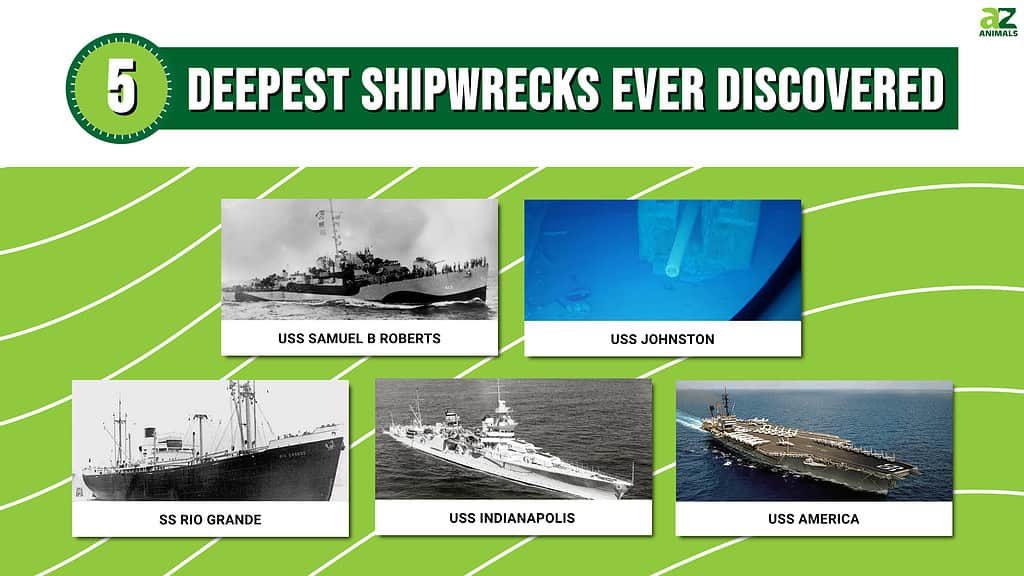
1. USS Samuel B Roberts

The USS
Samuel B Roberts, seen here just a week or two before it sank, is now the deepest shipwreck ever discovered.
©Naval History & Heritage Command / Public domain – Original / License
The USS Samuel B Roberts, casually known as “The Sammy B,” was a United States Navy destroyer escort in World War II. It was named after Coxswain Samuel Booker Roberts, Jr. The destroyer escort was commissioned in 1944.
The ship met its end in the Battle of Samar, which marked the final phase of the larger Battle of Leyte Gulf. It was the largest naval battle of World War II and one of history’s largest naval conflicts.
The Japanese Imperial Navy attacked a relatively small number of U.S. warships in this battle. Outmanned and outgunned, the crew of the Samuel B Roberts fought valiantly. They scored one torpedo hit and several shell hits on enemy ships before their own ship was hit with a Japanese torpedo. The ship sank off the Philippine island of Leyte.
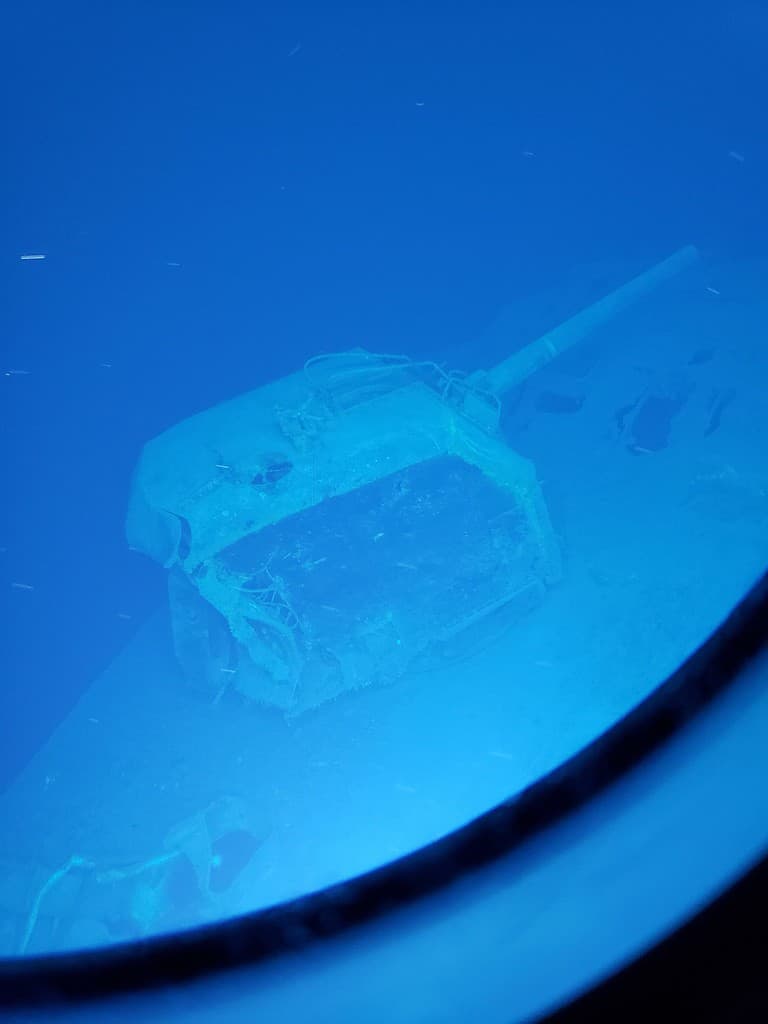
The
Samuel B Roberts‘ gun mount seen here was photographed by Vescovo’s crew in 2022.
Eighty-nine of the ship’s 224 crew members disappeared as the ship sank to its final resting place in the ocean depths. Adred Lenoir, the final surviving crew member of the Samuel B. Roberts, died in Alabama on March 20, 2022. He passed away just three months before the discovery of the ship’s wreckage.
Discovering the USS Samuel B Roberts Shipwreck
Victor Vescovo led an expedition that discovered the Samuel B Roberts shipwreck in June 2022. The team conducted a series of six dives to examine the wreckage.
The ship sunk to the bottom in one piece, although the damage inflicted by the Japanese torpedo is clear. The destroyer escort still appears to have live shells in its 40mm gun, along with depth charges still in their racks.
The Samuel B Roberts lies at a depth of 22,916 feet. That is over 4.3 miles below the ocean’s surface. It is about two miles deeper than the wreckage of the Titanic, which dominated the news in June 2023 when five people were killed in a submersible during a dive to the Titanic wreckage site.
The Samuel B Roberts is the deepest shipwreck ever discovered. The video below shows the remains of the wreckage found by Vescovo’s crew.
2. USS Johnston
The second-deepest shipwreck ever discovered fell victim to the same World War II battle as the Samuel B Roberts – the USS Johnston, which sunk during the Battle of Samar in the Philippine Sea.
The U.S. Navy named the Johnston after Lieutenant John V. Johnston, an officer during the Civil War. This Fletcher-class destroyer began its active duty in 1943.
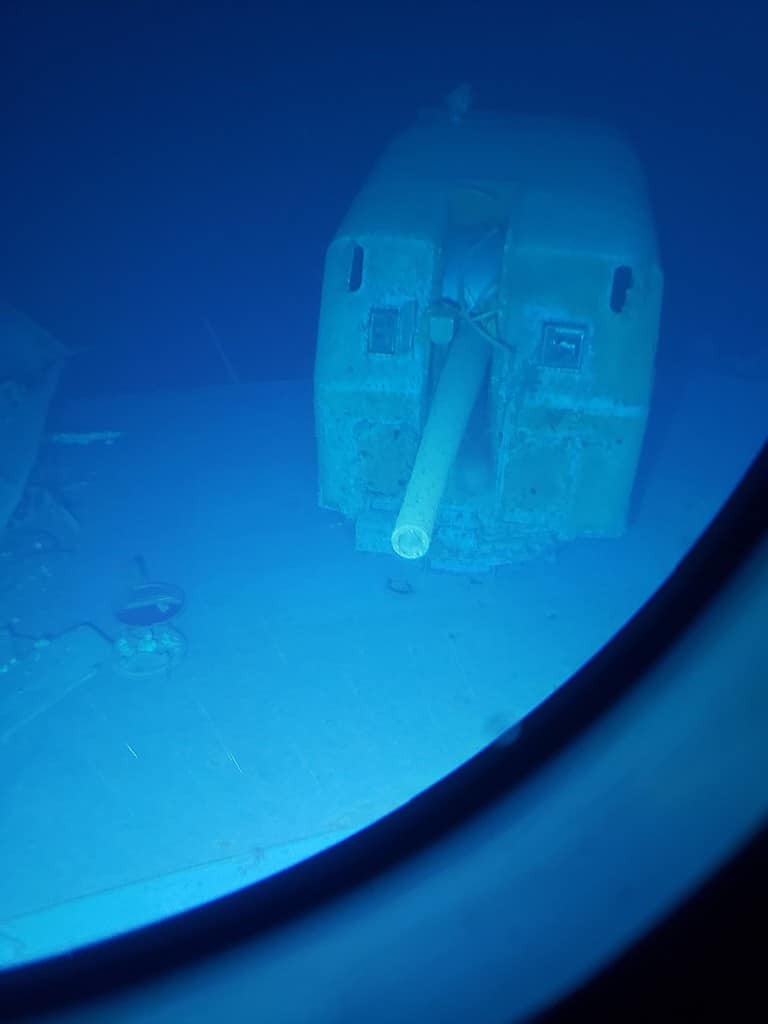
The USS
Johnstonhas rested on the floor of the Philippine Sea since 1944.
During the clash with the Japanese Imperial Navy on October 25, 1944, a fatal hit sank the destroyer. The incident claimed more than double the lives lost on the Samuel B Roberts, with one hundred eighty-seven crew members perishing with the Johnston.
In 2019, the first discovery of the ship’s wreckage occurred, but positive identification did not take place until March 2021. With a depth exceeding 20,000 feet, the Johnston held the record as the deepest shipwreck ever discovered until the discovery of the Samuel B Roberts the following year.
3. SS Rio Grande
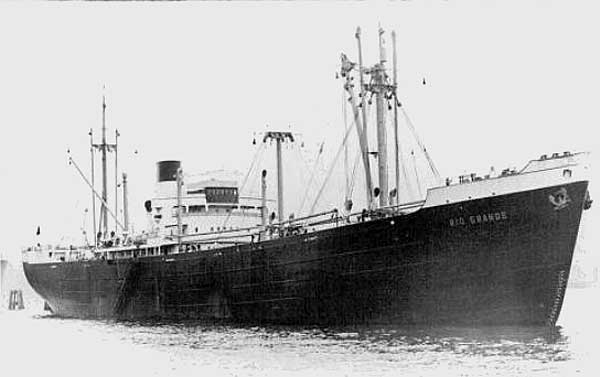
In January of 1944, two U.S. ships fired on the
Rio Grande, hitting it and sending it to the ocean floor.
©u – http://www.wrecksite.eu/img/wrecks/rio_grande_blocakde_runner.jpg / Public Domain – Original / License
The SS Rio Grande was a German blockade runner in World War II. Two American vessels, the USS Omaha and Jouett, spotted the ship in January 1944. The Rio Grande was sailing off the coast of Brazil. It was carrying cobalt, tin, and bales of crude rubber.
Once the German crew realized they had been targeted, they abandoned the ship and attempted to scuttle (intentionally sink) it. The U.S. ships fired on the Rio Grande, hitting it and sending it to the ocean floor.
The wreckage was discovered on November 30, 1996, using sonar technology and remotely operated vehicles. The Rio Grande sits 18,904 feet below the ocean’s surface.
Interestingly, cargo from the ship is now washing up on some beaches. Some of the rubber bales from the Rio Grande have appeared in Florida and, more recently, in Texas.
4. USS Indianapolis
The USS Indianapolis, named after Indiana’s capital city, was a Portland-class heavy cruiser launched in 1931. It played a vital role in the Allies’ World War II efforts by delivering uranium and components for “Little Boy,” the atomic bomb later dropped on Hiroshima, Japan, on August 6, 1945.

The U.S. Navy heavy cruiser USS
Indianapolis, seen here in 1939, delivered the components of the atomic bomb that was dropped on Hiroshima.
©Naval History & Heritage Command / Public domain – Original / License
Following this top-secret mission, a Japanese Imperial Navy submarine fired a torpedo that hit the Indianapolis. Within a mere 12 minutes, the ship sank. Three hundred of the crew members went down with it. The survivors faced exposure, dehydration, and shark attacks as they found themselves stranded in the open ocean. It took four days for a U.S. bomber on patrol to spot the survivors and for the U.S. Navy to become aware of the ship’s fate. Of the 1,195 crew members, only 316 survived, making the sinking of the Indianapolis the single deadliest ship disaster in U.S. Naval history.
On August 19, 2017, an expedition team funded by Microsoft co-founder Paul Allen found the ship. The Indianapolis now lies quiet on the ocean floor at a depth of roughly 18,000 feet.
5. USS America
This list technically doesn’t include the final ship, as it was never actually discovered. The U.S. government intentionally sunk the ship, so there was no need for such a discovery. Even though the government knew the ship’s final location, it remained a classified secret until they responded to a Freedom of Information Act request in 2006.
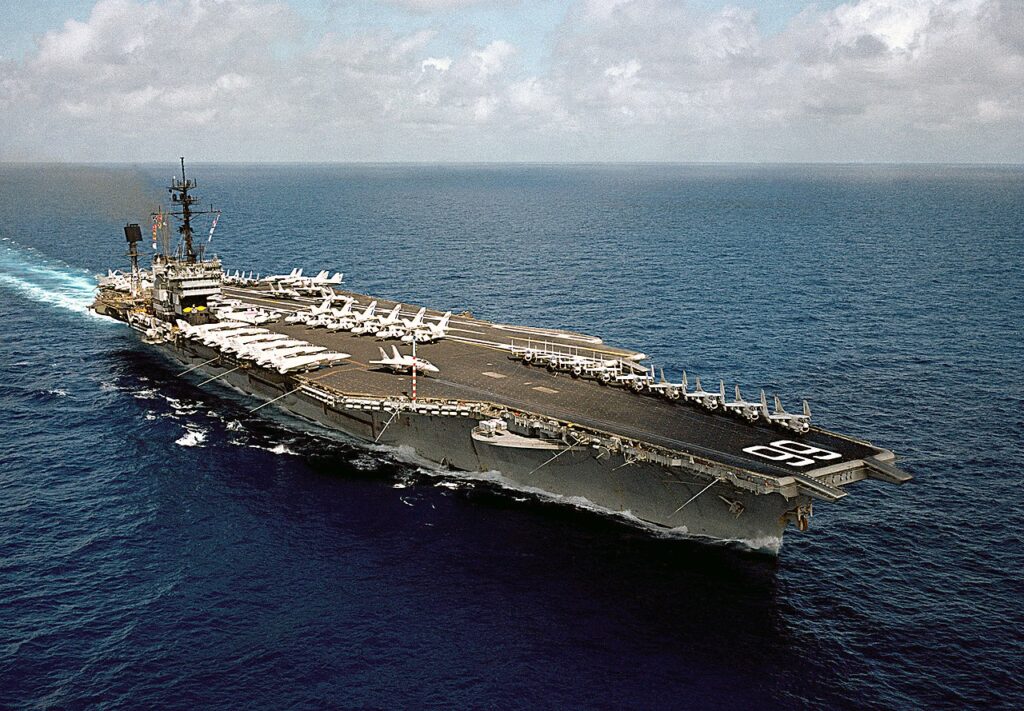
The USS America, seen here in 1983, was intentionally scuttled on May 14, 2005.
©U.S. Navy photo by Photographer’s Mate 2nd Class Robert D. Bunge / Public domain – Original / License
Commissioned on January 23, 1965, the USS America was a Kitty Hawk-class supercarrier. Over its illustrious service life, it was actively deployed in Middle East conflicts, the Vietnam War, Desert Storm, and numerous other missions.
On August 9, 1996, the Norfolk Naval Shipyard in Portsmouth, Virginia, decommissioned the ship. Initially, the plan was to sell it for scrap. But instead of selling the USS America, it ended up being spared from the scrapyard. In 2005, the ship became the chosen vessel for a live-fire test. This test aimed to collect data to enhance the design of future carriers.
Objections and Response
There was some vehement opposition to the scuttling of the ship. The symbolism of intentionally sinking a ship bearing the name of the United States was abhorrent to many. A group of former America crew members and many others lobbied to save the ship as a museum, but their efforts were unsuccessful.
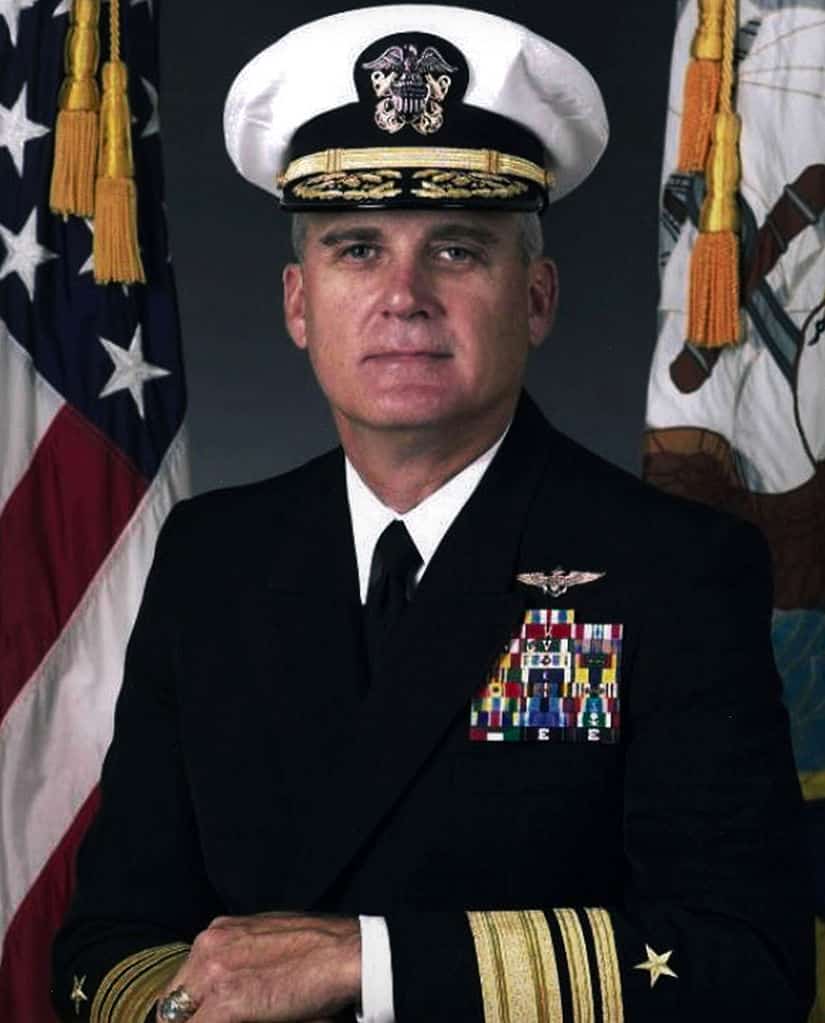
Admiral John B. Nathman explained to those opposed to the intentional scuttling of the USS
America.Admiral John B. Nathman, who was Vice Chief of Naval Operations at the time, released this statement in response to the opposition. “America will make one final and vital contribution to our national defense, this time as a live-fire test and evaluation platform. America’s legacy will serve as a footprint in the design of future carriers – ships that will protect the sons, daughters, grandchildren, and great-grandchildren of America veterans.
We will conduct a variety of comprehensive tests above and below the waterline collecting data for use by naval architects and engineers in creating the nation’s future carrier fleet. It is essential we make those ships as highly survivable as possible. When that mission is complete, the America will slip quietly beneath the sea. I know America has a very special place in your hearts, not only for the name but also for your service aboard her. I ask that you understand why we selected this ship for this one last crucial mission and make note of the critical nature of her final service.”
The Scuttling of the America
The live-fire tests on the America lasted four weeks. Finally, the ship sunk in a controlled scuttling on May 14, 2005. It sank approximately 290 miles southeast of Cape Hatteras, North Carolina. Today, the ship remains in one piece, sitting upright on the ocean floor at a depth of 16,860 feet. The ship measured over 1,047 feet long, making it the largest ship to ever be intentionally scuttled by its owners.
The photo featured at the top of this post is © Vlvescovo / CC BY-SA 4.0 – License / Original
Thank you for reading! Have some feedback for us? Contact the AZ Animals editorial team.







